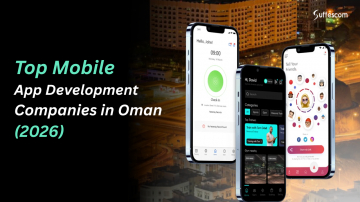How to Develop an AI Copilot for Enterprises?

The advancement of ChatGPT has escalated the race to adopt powerful and innovative AI models across the enterprise. This has sparked companies' curiosity about what is becoming known as "AI Copilots." which aim to boost efficiency and performance across various tasks. An AI copilot is an intelligent system designed to assist and collaborate with humans in complex tasks. It has penetrated every corner, from autonomous vehicles to medical diagnostics, and transformed how we interact with disruptive technology and each other.
This blog will discuss how a professional AI development company helps you develop an AI copilot and how it can benefit enterprises. So, let's get started by explaining what an AI copilot is.

What is an AI Copilot?
The AI Integration of the copilot represents a generative AI program that employs artificial intelligence to increase efficiency for various occupational activities and personal responsibilities. Through these technologies, users gain two hands or an intelligent guidance system, which helps them complete complex work while handling data better and making better decisions.
Artificial intelligence copilots represent large language models (LLMs) employed to execute automated work processes. These LLMs' human language comprehension functions allow copilots to understand and respond to verbal requests. This technology system provides more straightforward interactions that simultaneously boost digital platform efficiency.
Why Do Enterprises Need an AI Copilot?
Enterprises need to implement the AI Copilot solution to increase productivity and automate operations they would otherwise use for staff. Both functions of AI Copilot enable organizations to dedicate their work hours toward essential priorities. The following list explains why AI Copilots are necessary for enterprises:
- Efficiency and Productivity: The AI copilot system automates time-consuming operations, including data entry, scheduling functions, and handling customer support requests. The system enables staff members to direct their attention to jobs that demand their attention.
- Data-Driven Insights: AI Copilot completes assignments faster and more precisely than human performance. This tool enables data analysis for process optimization, automatic report generation, and decision-making tasks.
- Scalability: The process of business expansion requires AI copilot implementation to reduce operational costs. The method of scaling does not indicate work quality diminishes. You must implement AI copilot systems to achieve business growth.
- Enhanced Accuracy: The system produces precise results in customer service tasks, financial predictions, and inventory management executions. AI Copilot demonstrates superior skills in performing error-resistant work that surpasses human capabilities.
- Personalization: The AI Copilot system helps enterprises examine customer information, allowing them to offer customized support solutions based on individual customer requirements.
- Employee Satisfaction: The automation of manual tasks through AI Copilots helps employees produce better results at higher levels of importance. Organizations experience better job satisfaction coupled with successful retention of their best employees.
- Innovative Capabilities: Advanced capabilities delivered by AI include the integration of predictive analytics and machine learning models that were initially costly to execute and maintain. AI innovations allow organizations to create profitable new business models.

How Does an AI Copilot Work for Enterprises?
The following guide explains the sequential process used by AI copilot for enterprises to function.
1. Data Input: AI copilots extract data from organizational sources, including conversations with emails and databases, while processing documents and other information elements. The obtained information is the base for task learning and execution activities.
2. Data Analysis: Through machine learning algorithms, the AI copilot examines collected information to find meaningful patterns, essential trends, and valuable insights. The system manages efficient future customer query responses by examining historical customer communication patterns.
3. Natural Language Processing (NLP): The NLP applications of copilots enable them to produce natural-looking textual output. The system allows users to communicate with it through ordinary spoken language. The system interprets usually spoken instructions to execute responses or appropriate actions.
4. Decision-Making: AI copilots use analysis data to create decisions in addition to following pre-established objectives. Through its functionality, the AI copilot enables workers to sort their tasks and propose task completion solutions or handle scheduling responsibilities automatically.
5. Learning and Adaptation: One exceptional capability of AI copilots is their ability to acquire knowledge, which grows their performance capabilities over time. The constant process of updating their knowledge through machine learning models enables them to become more intelligent with each new interaction and improve their efficiency.
6. Integration and Interaction: AI enables operational connection between existing systems and workflows and platform and software tool connectivity. The system interfaces seamlessly to maintain consistent functionality between multiple data points and application products.

The 4 Types of AI Copilot For Enterprises
There are four types of copilot AI, each adding sophistication and supporting a progressively complex range of use cases. The first step is to examine the scope of your AI feature. Depending on the available data, you can determine the required level. An expert enterprise software development company can help you develop any of them quickly.
1. OpenAI's GPTs: The initial tier of AI assistance
- Primary Use Case: Specialized GPT
- Technology Base: Vectorized databases sourced from existing documentation and external APIs with function-calling capabilities.
AI-powered software development company help you integrate this copilot into your enterprises. OpenAI facilitates the creation of specialized chatbots using ChatGPT without coding. It supports document integration and utilizes web browsing, Dall-E, and Code Interpreter functionalities, enabling code execution and file interpretation. The Assistant API can be used to embed your model externally.
Benefits
- Simple setup using the ChatGPT no-code platform.
- Capable of handling basic tasks with your data and files.
- Included in the ChatGPT Plus plan at no extra cost, excluding API usage.
Limitations
- Performs only basic use cases.
- Restricted to GPTs within the ChatGPT interface if the OpenAI API is not utilized.
2. AI Chatbot: The second level of AI chat
- Primary Use Case: Support Questions
- Technology Base: Vectorized databases from existing documentation.
AI ChatGPT is designed to answer queries using information from documented sources.
Whenever you interact with customer service, chatbots retrieve answers from manuals or FAQs you're familiar with at this level.
Benefits
- Efficient handling of high volumes of common queries.
- Reduces the need for human intervention in basic inquiries.
- Instant access to extensive documentation.
Limitations
- Requires human intervention for uncommon queries.
- No access to live data; database updates require manual adjustment.
3. AI Assistant: The third level showcases AI chats
- Primary Use Case: Executing Actions
- Technology Base: Real-time communication with APIs, SQL, and vectorized databases.
Its ability to provide information and take action. These assistants can also schedule meetings, control smart home devices, or initiate complex business processes. It utilizes a direct interface with APIs in real-time. These act as digital aides, enhancing productivity across tasks. An expert AI development company helps you extract all the benefits of AI assistants.
Benefits
- Seamless integration with diverse tools and platforms.
- Automation and simplification of complex tasks.
- Increased productivity through minimized manual input.
Limitation
- Requires adaptation for APIs that may not be immediately compatible.
- Targets 95%+ use cases but within the confines of API capabilities.
4. AI Copilot
- Primary Use Case: Advisory and Action Delivery
- Technology Base: Real-time communication with internal and external APIs, SQL, and vectorized databases.
Venturing into one of the most advanced tiers of AI chat, we concluded the AI copilot. It's where the line between reactive response and proactive intuition blurs. This level is about answering queries or performing tasks, understanding context, predicting user requirements, and providing advisory insights.
Benefits
- Deep integration across various data platforms and sources.
- Proactive suggestions and strategic advisory.
- Comprehensive action capabilities, from simple tasks to complex decision-making processes.
Limitations
- Development time should be increased, possibly entailing the development of a specialized LLM.
Transform Your Business with AI Integration Services
Discover how an AI-powered assistant can streamline your operations and drive growth. Let's build the future of automation together!
How Does Enterprise Software Development Company Develop AI Copilot for Enterprises?
Step 1: Define Business Objectives and Use Cases
To create an AI Copilot system, developers must establish the business goals the solution must support. Businesses maintain different requirements, including process automation needs and AI-powered intelligence, to make better decisions. The development team needs to work with stakeholders, including business leaders and end-users, to identify fundamental functionalities alongside present challenges. The application of AI Copilot for customer support would prioritize two main functions: automated ticket sorting and immediate response capability. A Copilot designed to assist sales operations will help organizations score leads while creating individualized outreach initiatives. The definition of objectives guarantees that the AI Copilot matches corporate targets while providing measurable worth.
Step 2: Research & Select AI Technologies
After establishing use cases, it becomes essential to pick suitable AI technologies. The selection process requires deciding between proprietary AI models such as GPT-4 from OpenAI Gemini from Google or the open-source alternative from Meta named Llama. The choice of a copilot AI depends on three factors: scalability needs, domain restrictions, and security protocols the organization must meet. The technical framework needs NLP libraries, cloud AI services, and integration tools that enable enterprise system connectivity. The selected technology determines what the AI system can accomplish - particularly its language processing ability, context comprehension, and workflow complexity handling.
Step 3: Design AI Copilot Architecture
The design of the AI Copilot system requires technical planning and structured development for secure and efficient operation with enterprise-level processing needs. The copilot system arranges itself into four key components: user interface panels, an AI processing operation, and a context handling section besides API interface points for enterprise application connectivity. The system must deliver real-time performance, track user dialogue, and alter responses by observing user actions. Protecting sensitive business data requires compatible encryption protocols and identity verification procedures that ensure security. An adequately designed architecture allows the AI Copilot to function effectively between multiple enterprise operations and systems.
Step 4: Data Collection & Model Training
The actual effectiveness of an AI Copilot comes from its training using enterprise-specific data. The implementation stage requires collecting enterprise-specific data by processing emails, chat logs, customer interaction reports, and multiple business documents. AI training requires clean, structured information from data preprocessing as a crucial step for anonymization and information structure. Using domain-specific terminology during fine-tuning large language models enhances their ability to deliver precise and target-oriented responses. The performance of the AI system becomes more efficient through reinforcement learning methods, which rely on real-time user feedback. Corporate learning systems enable Copilot to adjust business operations to changing requirements.
Step 5: Develop & Integrate AI Features
Once the trained model becomes available, the development team implements core AI functionalities based on enterprise workflows. The system includes automated execution, predictive modeling, workflow management, and AI-based suggestion capabilities as fundamental features. The HR department could benefit from AI Copilot by streamlining interview scheduling and creating job descriptions while conducting employee engagement analyses. During integration, the system requires full connectivity to ERP (SAP), CRM (Salesforce), and ITSM platforms. Programming APIs enable Copilot Integration between the AI Copilot system and various data sources, allowing it to process information effectively.
Step 6: UI/UX Design & Development
The AI Copilot must have an intuitive, user-friendly interface that enhances user adoption. This involves designing a clean, responsive UI for web, mobile, and voice-enabled platforms. A chatbot interface powered by NLP enables conversational interactions, while dashboards provide visual insights and analytics. The UI design should prioritize ease of use, incorporating features like customizable workflows, voice commands, and accessibility options. A well-designed interface ensures that employees can interact with the AI Copilot effortlessly, leading to higher engagement and productivity.
Step 7: Testing & Validation
The testing procedure demands that the AI Copilot demonstrates proper functionality within different enterprise operational conditions. The functionality testing validates how features operate correctly, and the accuracy testing verifies that AI recommendations match the intended business goals. Security tests identify system weaknesses to confirm compliance with data security regulations, including GDPR and HIPAA standards. The analysis of performance under high traffic conditions happens through load testing operations. User Acceptance Testing (UAT) requires the deployment of Copilot to a selection of employees who test its usability alongside its effectiveness while making recommendations to enhance the system before general release.
Step 8: Deployment & Integration
The Copilot AI receives deployment to an enterprise environment through successful testing processes between on-premises and cloud-based platforms. AI infrastructure operates best through cloud deployment, which benefits from providers such as AWS, Google Cloud, and Azure, which deliver robust solutions. Data security guidelines that restrict data transmission can make enterprises choose on-site installation. After integration, the AI Copilot links with enterprise software to enable complete software exchange and automation capabilities. Businesses implement phased rollouts as their deployment strategy, allowing them to progressively integrate AI-powered features through performance review and user feedback assessment.
Step 9: Monitoring & Continuous Improvement
Post-deployment tracking of AI Copilot performance and user interactions requires constant monitoring as a mandatory step. The monitoring system uses analytics to measure precise response performance, system efficiency, and user involvement to identify effectiveness enhancements. The feedback loop provides AI-generated response refinement capabilities alongside adaptations of Copilot for real-time business needs. Security patches combined with compliance updates are released frequently to protect enterprise data. Enterprises will improve their abilities through continuous optimizations of the AI copilot for Enterprises, leading to lasting business results.
Step 10: Scaling & Customization
The AI Copilot needs to demonstrate initial success before enterprises can develop its features and adapt it for customized industrial applications. The AI Copilot can get better through the implementation of multilingual capabilities together with enhanced voice usability features, along with the addition of retrieval-augmented generation (RAG) capabilities. Enterprise AI solutions undergo customization based on different businesses operating within financial, healthcare, and logistics sectors so organizations can apply AI to their distinct operational needs. The expansion capabilities of the Copilot make it possible to process rising volumes of work and business requirements over time. Enterprises achieve the most value and continuous innovation through iterative improvements in their AI Copilot design.
Get Started with AI Copilot Today!
Empower your enterprise with cutting-edge AI technology. With our Enterprise software development services, enhance productivity, automate workflows, and stay ahead of the competition.
Conclusion
The development of AI copilots and their use in business processes is a big step forward. AI copilots help reduce tasks, make better choices, and work more efficiently. They play a key part as businesses operate in more complicated and competitive environments. When selecting the right AI copilot, you must consider security, compliance integration, scaling, and AI's ability to get people to use it. The choice must be based on a long-term plan that fits the company's goals and the specific needs of its operations.
FAQs
1. What is an AI Copilot, and how does it work?
An AI Copilot is an advanced AI-powered assistant developed by AI-powered software development services. It helps businesses automate tasks, analyze data, and improve decision-making. It works by processing input data, understanding user queries through natural language processing (NLP), generating insights, and executing tasks to boost efficiency and productivity.
2. What are the key benefits of using an AI Copilot in enterprises?
AI Copilots enhance efficiency by automating repetitive tasks, providing data-driven insights, improving accuracy, and reducing operational costs. They also enable better personalization in customer interactions and increase employee satisfaction by handling tedious workflows.
3. Can AI Copilots be integrated with existing enterprise software?
AI integration seamlessly compiles with various enterprise tools such as CRM, ERP, HR management systems, and communication platforms through APIs, plugins, and cloud-based services, ensuring smooth workflow automation.
4. What industries can benefit the most from AI Copilots?
Industries such as finance, healthcare, e-commerce, manufacturing, and customer service benefit significantly from AI Copilots. They assist in fraud detection, medical diagnostics, inventory management, and automated customer support.
5. How can a business develop and implement an AI Copilot?
AI integration requires collaboration with an AI development company. The process includes identifying business needs, selecting the right AI model, training it on enterprise data, integrating it with existing workflows, and continuously improving it through machine learning and user feedback.








